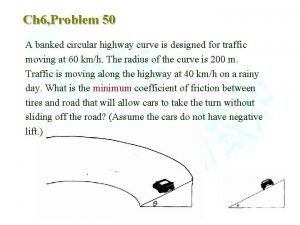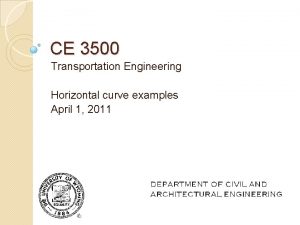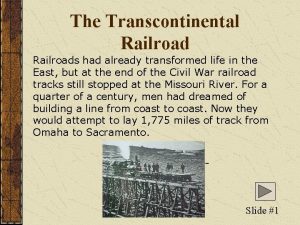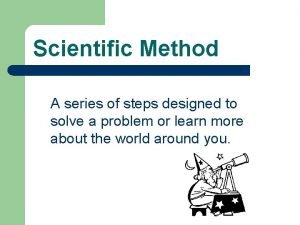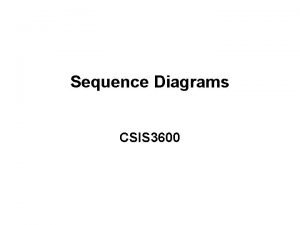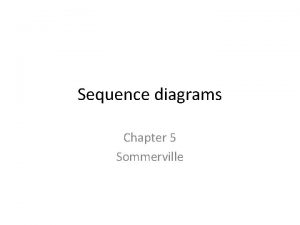Teachers Notes This sequence of slides is designed




















































- Slides: 52

Teacher’s Notes This sequence of slides is designed to introduce, and explain, the idea of Gradients on graphs , as explained on pages 363, 395, 128 -130 in Physics for You , 5 th edition. Note : When you start this Power. Point if you see a message about “Read-only embedded fonts” then you are recommended to select “Open Read-Only ” as this (i) gives a clearer font for those at the back of the room and (ii) ensures that the text-highlighting of key words is correct. On each slide the key points are revealed step by step, at the click of your mouse (or the press of a key such as the space-bar). Before making the next mouse-click you can ask questions of the class or make statements about what is about to be revealed. This should help students to become clearer about the ideas involved. Naturally it pays to have quick practice-run first. To start the slide-show, press function-key F 5 (or right-click->Full Screen) (to return to ‘normal view’ press the <Esc> key). For more (free) Power. Point presentations, visit www. physics 4 u. co. uk

Working Scientifically: Gradients on graphs Physics for You, 5 th edition, pages 363, 395, 128 -130

Learning Objectives You should learn : • How to calculate the gradient (slope) of a straight-line graph… • …and a curved graph • About the equations for different straight-line graphs. • The meaning of gradients on graphs for distance‒time and velocity‒time.

Looking at graphs What do we mean by… …the gradient of a graph…?

Looking at graphs Where is the curve steepest? Where does he accelerate the most? Where is the steepest gradient?

Looking at graphs Here the gradient is higher, and the rate of change of speed is higher.

Looking at graphs Here the gradient is smaller, and the rate of change of speed is smaller.

Gradient of a graph The slope or gradient of a graph can give you important information. But when you’ve drawn a graph… …how do you calculate the gradient of it? It can be done in 3 steps:

Gradient of a graph Here is the graph from an experiment to measure the extension of a spring (see page 66) It shows the load applied to the spring (in N) and the extension it causes (in mm).

Gradient of a graph Draw a large right-angled triangle as shown here: Step 1

Gradient of a graph Step 2 Find the value of the two sides Y and X in the units of the graph. In the diagram, Y = 20 mm and X = 60 N. Can you see why?

Gradient of a graph Step 3 Calculate the gradient (slope) of the graph by dividing Y/ X (Keep the units with the numbers, so that you find the unit of the gradient. ) From the diagram: gradient = Y = 20 mm X 60 N = 0. 33 mm/N

What if the graph is curved ? First, add a tangent at the point P where you want to find the gradient: Then find the gradient of that tangent line. gradient = Δy = 16 - 4 m/s = 12 m/s = 0. 63 m/s 2 Δx 19 s 27 - 8 s

Equations for straight-line graphs Let’s look at 3 examples of straight-line graphs, together with their algebraic equations. These are the 3 graphs we’ll look at:

Equations for straight-line graphs Directly proportional For an equation like Y=k. X the graph is a straight line, through the origin. The gradient (slope) = k For an example, see Hooke’s Law (page 66).

Equations for straight-line graphs Linear but not directly proportional For an equation like Y=k. X+c the graph is a straight line, but not through the origin. Like before, the gradient = k The intercept gives you the value of c. For an example see v = a t + u (page 131).

Equations for straight-line graphs Inversely proportional If pressure P and volume V are inversely proportional (see pages 29, 392) a graph of P against V would give a curve. The equation is P = k × 1 so to get a straight line, V 1 we have to plot: P against V

Looking at graphs of movement Let’s look at some examples of graphs with different gradients…

Distance – time graphs Example 1

Distance – time graph The What graph is happening is flat. The here? distance is not changing. The gradient is zero. The speed is zero.

Distance – time graphs Example 2

Distance – time graph What The distance is happening is changing. here? The object is moving. The constant gradient means a constant speed.

Distance – time graph What do the numbers tell you? The object has gone 20 m in 2 seconds. What is its speed?

Distance – time graph Speed = distance travelled time taken = 20 m 2 s = 10 m/s

Distance – time graphs Example 3

Distance – time graph The Whatgradient is happening (slope)here? is increasing. So the speed is increasing. The object is accelerating.

Distance – time graphs Example 4

Distance – time graph When What isishappening it travellingto fastest? the lift? When is it stationary? At B. (steepest) At A and at C. (flat)

Distance – time graph When is it accelerating? Between A-B. When is it decelerating? Between B-C.

Distance – time graph How far does it travel? How long does it take? What is its average speed? 35 metres 7 seconds 5 m/s

Now let’s look at a different set of graphs… …graphs of velocity) against time

Velocity – time graph Example 1

Velocity – time graph The Whatgraph is happening is flat. The here? velocity is not changing. It is not accelerating or decelerating.

Velocity – time graph Example 2

Velocity – time graph What The velocity is happening is changing. here? The object is accelerating.

Velocity – time graph Example 3

Velocity – time graph Now the gradient is steeper. The velocity is changing more quickly. The object has a greater acceleration.

Velocity – time graph Example 4

Velocity – time graph When travelling fastest? Between C and D. What is isithappening to this car? When is it stationary? At A and at E.

Velocity – time graph When is it accelerating? Between A and C. When is it decelerating? Between D and E.

Velocity – time graph Example 5

Velocity – time graph When travelling fastest? What is isithappening to this lift? At B. When is it stationary? At A and at C.

Velocity – time graph When is it accelerating? Between A and B. When is it decelerating? Between B and C.

Velocity – time graph What is the acceleration between A and B ?

Velocity – time graph Acceleration = gradient = Δy = 10 m/s = 2 m/s 2 Δx 5 s

Velocity – time graph What is the deceleration between B and C ?

Velocity – time graph Deceleration = gradient = Δy = 10 m/s = 5 m/s 2 Δx 2 s Or acceleration = ‒ 5 m/s 2

Learning Outcomes You should now: • Know how to calculate the gradient of a graph, • Understand the equations for straight-line graphs, • Know the meaning of gradients on graphs for distance‒time and velocity‒time.

For more details, see: Ø Physics for You, 5 th edition, page 363, 395, 128 -130 For more free Power. Points, visit Ø the web-site at www. physics 4 u. co. uk

If you are connected to the web at the moment, click below to see what’s available: http: //www. physics 4 u. co. uk/


 Kim kroll teachers pay teachers
Kim kroll teachers pay teachers A small child slides down the four frictionless slides
A small child slides down the four frictionless slides Starting from rest a marble first rolls down
Starting from rest a marble first rolls down Nucleotide to amino acid
Nucleotide to amino acid Example of sequence in pseudocode
Example of sequence in pseudocode What is the difference between finite and infinite sequence
What is the difference between finite and infinite sequence Convolutional sequence to sequence learning.
Convolutional sequence to sequence learning. Arithmetic explicit rule
Arithmetic explicit rule Conversion notes brutes en notes standard wisc 5
Conversion notes brutes en notes standard wisc 5 J=pi*d^4/32
J=pi*d^4/32 Specially designed instruction chart
Specially designed instruction chart Rpi denture design
Rpi denture design Every system is designed to get the results it gets
Every system is designed to get the results it gets Every system is designed to get the results it gets
Every system is designed to get the results it gets A program designed to send your advertisements, pop-ups
A program designed to send your advertisements, pop-ups Designed & developed by gstn
Designed & developed by gstn Dental accessory instruments
Dental accessory instruments Bogey tactic
Bogey tactic An internet is a collection of utility programs designed
An internet is a collection of utility programs designed Chapter 15 fire hose appliances and nozzles answer key
Chapter 15 fire hose appliances and nozzles answer key An unbanked circular highway curve
An unbanked circular highway curve Artificial intelligence devices
Artificial intelligence devices For a safe design a friction is designed by assuming
For a safe design a friction is designed by assuming Prolog language
Prolog language Smalltalk language
Smalltalk language Designed & developed by gstn
Designed & developed by gstn Lift slab operations must be designed and planned by
Lift slab operations must be designed and planned by A is the set of planned activities designed to result
A is the set of planned activities designed to result General ledger
General ledger What is a machine designed to do
What is a machine designed to do Characteristics of a well designed experiment
Characteristics of a well designed experiment Alfred binet designed the first ______ test.
Alfred binet designed the first ______ test. A group of activities designed to expedite transactions
A group of activities designed to expedite transactions Designed by
Designed by Smalltalk programming language
Smalltalk programming language Commercial data processing examples
Commercial data processing examples A horizontal curve is designed with a 2000-ft
A horizontal curve is designed with a 2000-ft A software consists of
A software consists of Universally designed allowances
Universally designed allowances Upon receipt of a bad segment, udp?
Upon receipt of a bad segment, udp? Disadvantage of micro teaching
Disadvantage of micro teaching Who designed futura
Who designed futura For bheem
For bheem Advertising is a message designed to promote
Advertising is a message designed to promote Designed by freepik.com
Designed by freepik.com In 1864 george pullman designed
In 1864 george pullman designed Kevin wolf bis
Kevin wolf bis A copita is a glass designed for this fortified wine
A copita is a glass designed for this fortified wine A series of steps designed to solve a problem
A series of steps designed to solve a problem Panel discussion definition
Panel discussion definition In 1864 george pullman designed
In 1864 george pullman designed Characteristics of properly designed selection tests
Characteristics of properly designed selection tests Mod-7 asynchronous up counter is designed with:
Mod-7 asynchronous up counter is designed with:




















